It’s all to easy to cook too much rice but thankfully there are lots of ways to use it up.
Food safety warning: bacteria, specifically Bacillus cereus, loves cooked rice – and it can quickly grow to dangerous levels. Minimise it’s growth by cooling it quickly, put it in the fridge as soon as possible then use it with a day or so.
1. Rice pudding
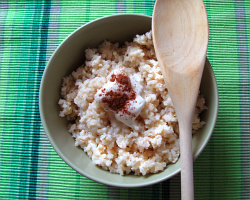 Rice pudding is eaten all over the world in one form or another. The general principle is the same – cook the rice in milk then when it’s tender, add a sweetener (sugar, honey or fruit syrup) and something to give it a bit more flavour such as cream, egg yolk, fruit or nuts and spices such nutmeg & cinnamon. There are thousands of different ways to make it – experiment to find your favourite!
Rice pudding is eaten all over the world in one form or another. The general principle is the same – cook the rice in milk then when it’s tender, add a sweetener (sugar, honey or fruit syrup) and something to give it a bit more flavour such as cream, egg yolk, fruit or nuts and spices such nutmeg & cinnamon. There are thousands of different ways to make it – experiment to find your favourite!
Leftover cooked rice can be used in place of dry rice – particularly if you’re happy to have a mushier pudding in the end. When making it fresh, most people use short grain rice but anything will do – white or brown, long or short, basmati, jasmine – whatever you’ve got on the go.
One of my favourite rice pudding recipes is with coconut and mango – yum!
2. Add it to soup
Leftover rice – again, any time – is great as a bulking agent in soup. Added early on, it breaks down and makes the whole soup thicker; added towards the end, it provides scoopable particles to chase around the bowl.
Add it to a hearty minestrone, or a tasty Moroccan veg soup – or add it to a simple chicken soup for those days when your belly needs something nice and bland.
3. Stuffed peppers (or marrow)
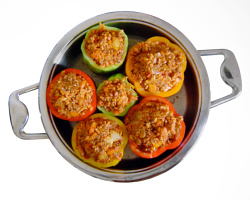 You can quickly make a tasty dinner by stuffing bell pepper or marrow rings with leftover rice.
You can quickly make a tasty dinner by stuffing bell pepper or marrow rings with leftover rice.
Cut the top off the bell pepper and remove any seeds/white bits, then mix the rice with any meat, veggies or herbs you fancy, top with a bit of cheese and bake in a medium oven for about half an hour.
As with rice pudding, everyone has their own way of making them with their own favourite ingredients. Some great examples to get you started: beans and rice stuffed peppers; courgette, basil and rice ones; and super saucy tomato and beef mince ones.
To be extra frugal, use whatever meat or veggies you’ve got leftover alongside the rice – a little chilli con carne or casserole is perfect to stir in and lightly flavour the rice.
4. Bake it into bread – or muffins
Have you ever tried rice bread? Not rice cakes, those boring puffy white things but actual proper bread? If not, you should – it’s great and since you need to cook the rice down into a mush, starting with leftover cooked rice will save you time as well as preventing waste.
Check out this video how-to to see how it’s done.
Alternately, fancy something sweeter? Then I give you vanilla rice muffins.
5. Fried rice
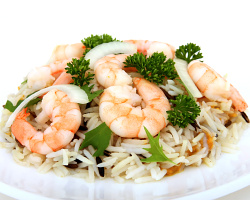 Finally, no “uses for leftover rice” list would be complete without fried rice. Fried rice is best made with cooked rice left to go cold so it’s perfect for using up leftovers.
Finally, no “uses for leftover rice” list would be complete without fried rice. Fried rice is best made with cooked rice left to go cold so it’s perfect for using up leftovers.
Again, there are a billion varieties and flavours. A simple recipe makes a good side dish but a couple more ingredients – some meat, fish, tofu or exciting veg – and you’ve got yourself a tasty main meal. Try this flavourful chicken and prawns recipe.
Reduce!
Reduce food waste – only cook as much rice as you need each time. Find a cup or dish that makes the correct amount and measure it out each time.
What’s your favourite thing to do with leftover rice?
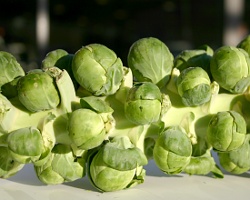 Long time Recycle This-er Lizzy has asked about “the big brussels sprout stalk thing”:
Long time Recycle This-er Lizzy has asked about “the big brussels sprout stalk thing”:


 Rice pudding is
Rice pudding is  You can quickly make a tasty dinner by stuffing bell pepper or marrow rings with leftover rice.
You can quickly make a tasty dinner by stuffing bell pepper or marrow rings with leftover rice. Finally, no “uses for leftover rice” list would be complete without fried rice. Fried rice is best made with cooked rice left to go cold so it’s perfect for using up leftovers.
Finally, no “uses for leftover rice” list would be complete without fried rice. Fried rice is best made with cooked rice left to go cold so it’s perfect for using up leftovers. Hey guys, sorry I haven’t got time to write a full Recycle This post today – but can I point you to the latest article on my new blog
Hey guys, sorry I haven’t got time to write a full Recycle This post today – but can I point you to the latest article on my new blog 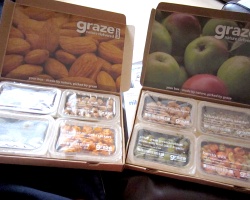 Ok, this is a bit of a rant dressed up as a Recycle This style question – it’s a genuine question but I feel the need to rant too! ;)
Ok, this is a bit of a rant dressed up as a Recycle This style question – it’s a genuine question but I feel the need to rant too! ;)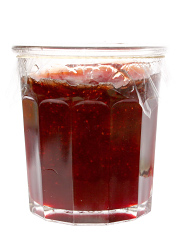 It’s very definitely jam season at the moment (in the UK at least) and I thought it might be fun to hear people’s favourite fixes for sticky situations (ho ho!) when the preserves don’t come out quite as you’d hoped.
It’s very definitely jam season at the moment (in the UK at least) and I thought it might be fun to hear people’s favourite fixes for sticky situations (ho ho!) when the preserves don’t come out quite as you’d hoped.














